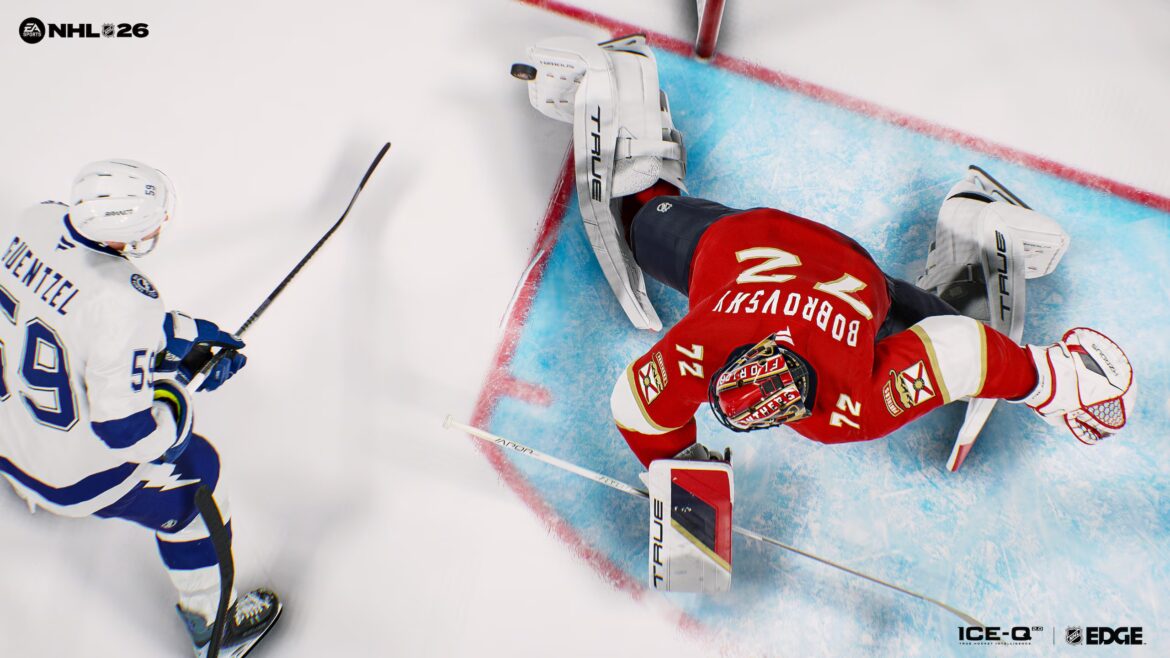I’ve always loved sports, from football (soccer) to darts; if there’s some kind of competition on TV, I’ll be watching. It wasn’t until last year, however, that I got the hockey bug, and ever since I’ve been engulfed by the world of the NHL.
I’ve fallen in love with ice hockey so much that I’m now a season ticket holder for my local ice hockey team in Scotland, and while the level isn’t on par with the incredible abilities on display in the NHL, it captures the soul of the game.
Review info
Platform reviewed: PS5
Available on: PS5, Xbox Series X|S
Release date: September 12, 2025
Why am I talking about my newfound love for hockey, you ask? Well, the last EA NHL game I purchased was NHL 16, and despite playing trials sporadically over the years, I’ve never truly immersed myself in the world of Chel.
This all changed with NHL 26, the latest video game in the annual ice hockey series, and the first time I’ve ever played a hockey game with pretty good knowledge of the current teams and rosters.
This is my review of NHL 26, from the eyes of someone who’s found a new passion for ice hockey as the sport quickly becomes my go-to weekend television.
It’s in the game
For a little bit of extra background, I played the 10-hour free trial of NHL 25 when it launched last year, and while I enjoyed it, my lack of hockey interest at the time severely impacted my decision not to purchase the full game.
Fast forward 12 months, and everything has changed. I’ve got tickets to my first NHL game, I watched the whole of last season almost religiously, and I have a massive urge to get good at scoring slap shots from almost anywhere on the ice.
Like most sports video game franchises, each annual release brings new rosters, new jerseys (in the case of hockey, sweaters), and some improvements to gameplay to try and warrant a new full price tag. Compared to my previous experience with NHL 25, NHL 26 seems to build on everything that made that game an excellent sports simulation, while also adding new features to make the gameplay feel fresh.
(Image credit: EA / NHL)
NHL 26 introduces ICE-Q 2.0, a new engine that makes players feel more like their real-life skating counterparts. EA says ICE-Q 2.0 is “fueled by NHL EDGE positional data,” and real-world data has an impact on player attributes.
I noticed this first-hand when trying out Connor McDavid, who felt as quick and skillful in NHL 26 as he does while I’m watching him play for the Oilers on TV. Each player has specific tendencies pulled from the data, which means they perform more like themselves than ever before. Players like Leon Draisaitl hold their position like in real life, making him lethal from the right side of the net, able to smash the puck in from a tight angle.
I really appreciated the uniqueness of star players across the NHL, and combined with X-Factors (specific skills unique to the players in real-life), I found the gameplay incredibly engaging and layered. As someone who has grown up with FIFA (now EA FC 26), I found the complexity of the gameplay in NHL 26 very refreshing.
EA has put a big effort into improving the presentation of the game using ICE-Q 2.0, too, with new extended replays combined with insights and more immersive audio that makes the game feel as close to the real thing as possible.
(Image credit: EA / NHL)
Heading for the Stanley Cup
I played a lot of Franchise mode in the week or so I’ve spent with NHL 26, and I really enjoyed having an input into all of the elements that go into running an elite team. From working on your marketing budget to juggling salary caps with trades, I found myself playing the offline career mode far more than I’d ever have expected to.
I’ve taken fondly for the Montreal Canadiens, and considering the team’s huge prospects for success in the next decade, building the team and taking them on a late playoff run was really satisfying.
I decided to have lots of control over everything going on behind the scenes, but if you choose to, you can let the AI control everything and just focus on the performances on the ice.
Franchise mode was probably my favorite gamemode on NHL 26, but it’s only had small incremental improvements compared to the experience on its predecessor.
A lot of time has been put into revamping Be a Pro in NHL 26, where a new chapter-based progression system with all-new cutscenes and cinematics brings the feeling of being a future ice hockey star to life.
Best bit
(Image credit: EA / NHL)
NHL 26 is one of the most realistic sports games I’ve ever played, and as someone who’s trying to immerse themselves in the world of ice hockey as much as possible, it’s a joy to experience the slick and speedy action on the rink.
I’m not a huge fan of these kinds of game modes in sports games; in fact, FIFA 17’s The Journey completely turned me off wanting to experience the life of a player, but for those who do like focusing on building a star, the new changes here will scratch the itch.
Just like other sports games in EA’s portfolio, NHL 26 puts an emphasis on Ultimate Team, and love it or loathe it, it’s an incredibly popular game mode. This year, HUT has a Cup Chase game mode that allows you to progress offline to earn rewards to improve your team. There are also new team-building mechanics and salary caps to make the game more competitive online.
During my review period with NHL 26, I wasn’t able to play online, but I did enjoy building a somewhat respectable Ultimate Team. The problem with modes like this is the emphasis on blind boxes (packs) and spending real money to get the players you know and love. I have not played HUT for an extended period of time, so I don’t know how bad it is in NHL 26, but if it’s anything like my experience of EA FC Ultimate Team, it can be a dangerous game that leads to throwing cash away for minimal reward.
Face off
Ice hockey games have always shone when it comes to multiplayer, so I invited my friend round for some couch co-op to check out the modes in NHL 26.
Now, I want you to remember that I’m a massive novice when it comes to ice hockey games, and my friend, who’s also a huge NHL fan, hadn’t played one of these games for well over a decade.
I’d say, in general, I’m a pretty good gamer. I used to compete in FIFA tournaments when I was younger, and I’m currently bruteforcing my way through Hollow Knight: Silksong, despite backlash online with people crying it’s too hard.
That said, NHL 26 was impossibly hard for a beginner, and even after changing the speed and power of our shots, my friend and I really struggled to score goals on the ice.
It got so bad, in fact, that we tried training mode with 5 players against a goalie, and even then, nothing seemed to click. Now, obviously, this is a skill issue, and actually, I really appreciate there being a learning curve to get good at the game, but I have an issue with the lack of training and tips.
I turned on all the beginner trainer pop-ups for in-game, which showed me what to do and when, but even then, nothing seemed to click. And unlike games like Madden 26, there was no training facility to learn the ropes; NHL 26 just assumed that anyone playing the game was already familiar with it.
My friend and I had an 8-time overtime game that ended 1-0, and let’s just say the only way we were getting through the pain of being terrible at finishing our chances was by ingesting copious amounts of beer (We couldn’t score before the drinking).
Something is fascinating about how difficult NHL 26 is, however, and the need to really learn the ins and outs of ice hockey keeps me coming back for more. I was able to sneak my way into the playoffs in Franchise Mode, but if I want to win the Stanley Cup, I’m going to have to train harder and smarter to actually get good at scoring goals.
Should you play NHL 26?
Play it if…
You want to immerse yourself in the world of NHL
NHL 26 is the best ice hockey game on the market, and it does an excellent job at capturing what makes the sport one of the most exciting on the planet. If you’re into hockey or want to be, NHL 26 is the sports game for you.
You don’t own NHL 25
I can’t say for certain that NHL 26 is worth picking up if you own NHL 25 because, quite frankly, I dream of a world without annual sports video game releases. That said, NHL 26 is a damn good sports game, so if you love everything hockey or don’t own NHL 25, it’s a must-play.
Don’t play it if…
You’ve not got patience
Unless you’re a seasoned veteran, NHL 26 is not a pick-up and play experience. In fact, it’s probably one of the hardest sports games for a beginner I’ve ever tried. If you don’t have time to invest in learning the ropes, NHL 26 isn’t for you
Accessibility
NHL 26 is filled with accessibility features to set the game up exactly as you want it. With multiple control schemes and basic controller remapping, there are different ways to play depending on your needs and preferences.
Gameplay accessibility is supported via adjustable difficulty levels (with more granular “advanced” difficulty options) as well as control reminders (so players can see how to do certain moves or actions).
How I reviewed NHL 26
I played over 30 hours of NHL 26 on PS5 Pro connected to my Samsung S90D, one of the best OLED TVs on the market.
I tested all of the main game modes, spending most of my time in Franchise Mode and playing exhibition matches with my friend via couch co-op.
I’ve played a whole host of sports games over the years and have reviewed EA FC 25 and WWE 2K25 in recent months. While I’m a novice to NHL video games, I know quite a bit about the sport and used my experience to compare the real-life action with the gameplay on my PS5.
First reviewed September 2025


